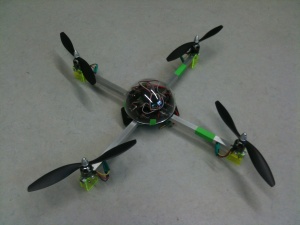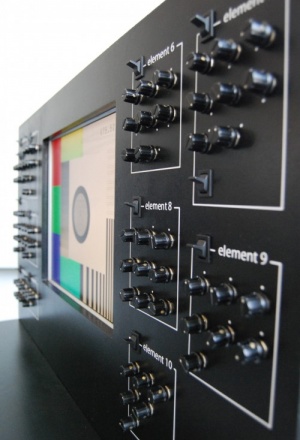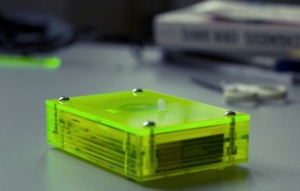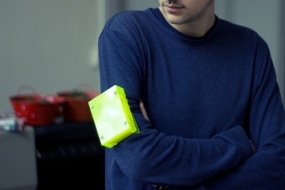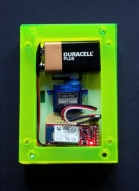User:Jasper van Loenen/grad/draft proposal v2: Difference between revisions
No edit summary |
No edit summary |
||
| Line 10: | Line 10: | ||
<p>Looking for inspiration for the graduation project I focused on the practical projects I've done - the work related to my love for physical installations and electronics. I looked into some different things like teleconferencing and AI, but both felt quite forced; the topics are interesting, but it they are not really things I ever worked on before. While I was looking into these subjects, I was doing a small side-project for myself and I decided to use this project in my graduation project.</p> | <p>Looking for inspiration for the graduation project I focused on the practical projects I've done - the work related to my love for physical installations and electronics. I looked into some different things like teleconferencing and AI, but both felt quite forced; the topics are interesting, but it they are not really things I ever worked on before. While I was looking into these subjects, I was doing a small side-project for myself and I decided to use this project in my graduation project.</p> | ||
<p>What I was doing, was building a quadcopter - a small radio-controlled | <p>What I was doing, was building a quadcopter - a small radio-controlled UAV (unmanned aerial vehicle) with 4 propellors. At first I didn't want to use this for my graduation project because it started as something that was just for fun. But after giving it some more thought, I noticed that it touches on several of the topics I was interested in when I signed up for the Networked Media course. First of all, it is something I built myself using techniques from the maker scene - in this case laser cutting and 3D printing - and all the software used is all open source and is being developed by a community, in which I've become involved as well.</p> | ||
<p>Apart from being a interesting technical subject, the availability of these things that are able to fly around raises all kinds of interesting questions, like about privacy and legality. Another interesting aspect is that people, as intrigued as they can be by flying things, are often just as scared of them. I've already noticed this during the few times I've flown the quad around. Also, a lot of people tend to see these small UAVs in the same light as the bigger military ones.</p> | |||
<p>Because of this - ungrounded - fear, I think it will be interesting to try to come up with ways to use them in a positive way - and not just a flying toy. I believe there are multiple things you could do with them, but to keep the project from becoming too broad it will be good to narrow it down to one topic. One of the first 'odd' things I wanted to do with it, was to use it to distribute seeds - possible using gps to guide it and make a pattern, drawing or text - the main direction will be to use the quadcopter as a tool for urban / guerilla gardening.</p> | |||
== Relation to a larger context == | |||
<p>People always thought about making things - or themselves - fly. But where this used to be too technical, or too expensive, everyone with a basic sense of how to put stuff together can now build his or her own flying machine, especially when tapping into the maker scene with techniques like 3D printing and laser cutting. But the possibility of building these machines also raises questions, like who actually owns the sky, for instance. If I fly around my backyard, that should be ok, but how high can I go before I leave my property and enter restricted airspace. Suddenly your garden gets a border in the 3D dimension.</p> | |||
<p>Also, a lot of people are afraid of these things flying around, for instance because of privacy concerns or because they think terrorist will use them as weapons. This is often the angle media take on the subject, comparing them to the larger military drones. But there is also a whole other area to explore, one that uses uavs for more interesting things than blowing things up.</p> | |||
| Line 27: | Line 34: | ||
<p>Both of these projects were largely born out of an interest for technology and building things from scratch.</p> | <p>Both of these projects were largely born out of an interest for technology and building things from scratch.</p> | ||
== Practical steps == | == Practical steps == | ||
Revision as of 15:52, 28 November 2012
Tentative Title
< Insert Very Tentative Title Here >
General Introduction
Looking for inspiration for the graduation project I focused on the practical projects I've done - the work related to my love for physical installations and electronics. I looked into some different things like teleconferencing and AI, but both felt quite forced; the topics are interesting, but it they are not really things I ever worked on before. While I was looking into these subjects, I was doing a small side-project for myself and I decided to use this project in my graduation project.
What I was doing, was building a quadcopter - a small radio-controlled UAV (unmanned aerial vehicle) with 4 propellors. At first I didn't want to use this for my graduation project because it started as something that was just for fun. But after giving it some more thought, I noticed that it touches on several of the topics I was interested in when I signed up for the Networked Media course. First of all, it is something I built myself using techniques from the maker scene - in this case laser cutting and 3D printing - and all the software used is all open source and is being developed by a community, in which I've become involved as well.
Apart from being a interesting technical subject, the availability of these things that are able to fly around raises all kinds of interesting questions, like about privacy and legality. Another interesting aspect is that people, as intrigued as they can be by flying things, are often just as scared of them. I've already noticed this during the few times I've flown the quad around. Also, a lot of people tend to see these small UAVs in the same light as the bigger military ones.
Because of this - ungrounded - fear, I think it will be interesting to try to come up with ways to use them in a positive way - and not just a flying toy. I believe there are multiple things you could do with them, but to keep the project from becoming too broad it will be good to narrow it down to one topic. One of the first 'odd' things I wanted to do with it, was to use it to distribute seeds - possible using gps to guide it and make a pattern, drawing or text - the main direction will be to use the quadcopter as a tool for urban / guerilla gardening.
Relation to a larger context
People always thought about making things - or themselves - fly. But where this used to be too technical, or too expensive, everyone with a basic sense of how to put stuff together can now build his or her own flying machine, especially when tapping into the maker scene with techniques like 3D printing and laser cutting. But the possibility of building these machines also raises questions, like who actually owns the sky, for instance. If I fly around my backyard, that should be ok, but how high can I go before I leave my property and enter restricted airspace. Suddenly your garden gets a border in the 3D dimension.
Also, a lot of people are afraid of these things flying around, for instance because of privacy concerns or because they think terrorist will use them as weapons. This is often the angle media take on the subject, comparing them to the larger military drones. But there is also a whole other area to explore, one that uses uavs for more interesting things than blowing things up.
Relation to previous practice
My previous work often dealt with the manifestation of digital systems; Test Screen was an interface to connect to an abstract piece of code. The installation consists out of groups of dials and switches (96 in total) around a flatscreen monitor, set in a large (110x60cm) wooden panel. I wrote a small computer program that would display an image similar to the old television test screens and each of the dials and switches was connected to a part of the script of this program. By manipulating the controls, the audience was able to change my code and change what would be displayed. I choose to not use a generic computer with keyboard and mouse but to built a custom interface as a way to get the audience more involved, since for many using such an unknown interface is far more appealing - and telling by the time some visitors spent at the installation it worked. The form of the object (it's size and layout of switches and dials) was based on the code you were able to change with it and wouldn't really fit any other program - it reflected the character of the system.
The same can be said for The Poking Machine (TPM), which I made together with Bartholomäus Traubeck. Facebook Users can poke each other by clicking a button on their profile pages and the recipient will receive a message saying he or she was poked. TPM is a small (9 x 7 x 5 cm) box made out of green transparent Perspex which you can strap to your upper arm using the attached piece of velcro. It will then use your phoneʼs internet connection to keep track of incoming pokes and when it detects one, a small plastic lever will come out of the box to physically poke you in the arm. This translates this meaningless written message into an actual poking gesture.
Both of these projects were largely born out of an interest for technology and building things from scratch.
Practical steps
Even though it needs some fine-tuning, I already have a working quadcopter. There are now two directions to go in. At the moment the shape is that of a common quadcopter. This means it can now go in two directions: seeing the quad as an object, the shape would have to change, since its appearance become important. The other directions would be to see it as a tool, and see what kind of things you can use it for. This is something I'm looking in to at this point.
References
- P.W. Singer, (2010) Wired for War
- N. Katherine Hayles, (2005) My mother was a computer
- N. Katherine Hayles, (1999) How we became post human, virtual bodies in cybernetics, literature, and informatics
- R Barbrook (2005) Imaginary Futures,
- Where is my robot? (2008), Danny Wallace
- Isaac Asimov
Hoffmann, E.T.A., (1816) The Sandman
The Hunt for AI (2012), Marcus Du Sautoy
Hugo (2011), Martin Scorsese (based on the children's book by Brian Selznick)

